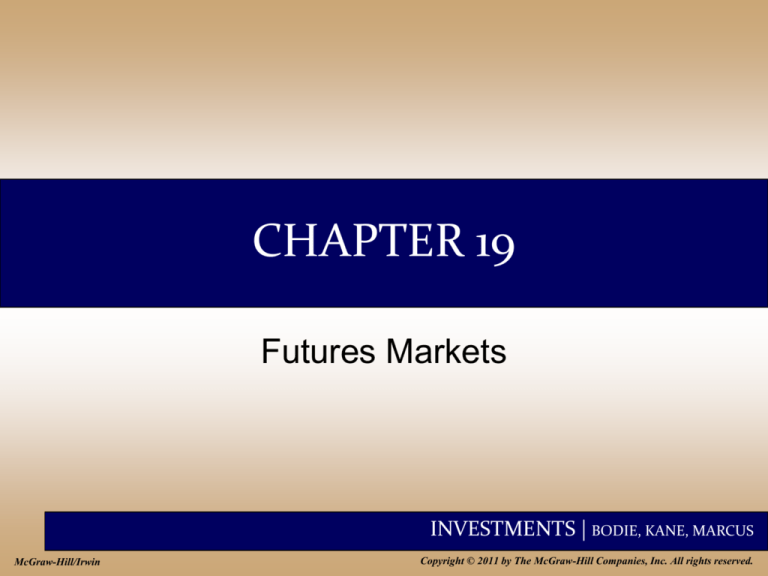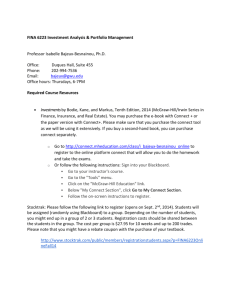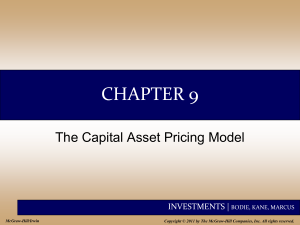
CHAPTER 19
Futures Markets
INVESTMENTS | BODIE, KANE, MARCUS
McGraw-Hill/Irwin
Copyright © 2011 by The McGraw-Hill Companies, Inc. All rights reserved.
19-2
Futures and Forwards
• Forward – a deferred-delivery sale of an
asset with the sales price agreed on
now.
• Futures - similar to forward but feature
formalized and standardized
contracts.
• Key difference in futures
– Standardized contracts create
liquidity
– Marked to market
– Exchange mitigates credit risk
INVESTMENTS | BODIE, KANE, MARCUS
19-3
Basics of Futures Contracts
• A futures contract is the obligation to
make or take delivery of the underlying
asset at a predetermined price.
• Futures price – the price for the
underlying asset is determined today, but
settlement is on a future date.
• The futures contract specifies the
quantity and quality of the underlying
asset and how it will be delivered.
INVESTMENTS | BODIE, KANE, MARCUS
19-4
Basics of Futures Contracts
• Long – a commitment to purchase the
commodity on the delivery date.
• Short – a commitment to sell the
commodity on the delivery date.
• Futures are traded on margin.
• At the time the contract is entered into, no
money changes hands.
INVESTMENTS | BODIE, KANE, MARCUS
19-5
Basics of Futures Contracts
• Profit to long = Spot price at maturity - Original
futures price
• Profit to short = Original futures price - Spot
price at maturity
• The futures contract is a zero-sum game, which
means gains and losses net out to zero.
INVESTMENTS | BODIE, KANE, MARCUS
19-6
Figure 19.2 Profits to Buyers and Sellers
of Futures and Option Contracts
INVESTMENTS | BODIE, KANE, MARCUS
19-7
Figure 19.2 Conclusions
• Profit is zero when the ultimate spot price,
PT equals the initial futures price, F0 .
• Unlike a call option, the payoff to the long
position can be negative because the
futures trader cannot walk away from the
contract if it is not profitable.
INVESTMENTS | BODIE, KANE, MARCUS
19-8
Existing Contracts
• Futures contracts are traded on a wide
variety of assets in four main categories:
1.
2.
3.
4.
Agricultural commodities
Metals and minerals
Foreign currencies
Financial futures
INVESTMENTS | BODIE, KANE, MARCUS
19-9
Trading Mechanics
• Electronic trading
has mostly
displaced floor
trading.
• CBOT and CME
merged in 2007 to
form CME Group.
• The exchange acts
as a clearing house
and counterparty to
both sides of the
trade.
• The net position of
the clearing house is
zero.
INVESTMENTS | BODIE, KANE, MARCUS
19-10
Trading Mechanics
• Open interest is the number of contracts
outstanding.
• If you are currently long, you simply
instruct your broker to enter the short side
of a contract to close out your position.
• Most futures contracts are closed out by
reversing trades.
• Only 1-3% of contracts result in actual
delivery of the underlying commodity.
INVESTMENTS | BODIE, KANE, MARCUS
19-11
Figure 19.3 Trading without a Clearinghouse;
Trading with a Clearinghouse
INVESTMENTS | BODIE, KANE, MARCUS
19-12
Margin and Marking to Market
• Marking to Market - each day the profits or
losses from the new futures price are paid
over or subtracted from the account
• Convergence of Price - as maturity
approaches the spot and futures price
converge
INVESTMENTS | BODIE, KANE, MARCUS
19-13
Margin and Trading Arrangements
• Initial Margin - funds or interest-earning
securities deposited to provide capital to
absorb losses
• Maintenance margin - an established value
below which a trader’s margin may not fall
• Margin call - when the maintenance margin
is reached, broker will ask for additional
margin funds
INVESTMENTS | BODIE, KANE, MARCUS
19-14
Trading Strategies
Speculators
• seek to profit from price
movement
– short - believe price will fall
– long - believe price will rise
Hedgers
• seek protection from price
movement
– long hedge - protecting
against a rise in purchase
price
– short hedge - protecting
against a fall in selling price
INVESTMENTS | BODIE, KANE, MARCUS
19-15
Basis and Basis Risk
• Basis - the difference between the
futures price and the spot price, FT –
PT
• The convergence property says FT –
PT= 0 at maturity.
INVESTMENTS | BODIE, KANE, MARCUS
19-16
Basis and Basis Risk
• Before maturity, FT may differ
substantially from the current spot
price.
• Basis Risk - variability in the basis
means that gains and losses on the
contract and the asset may not
perfectly offset if liquidated before
maturity.
INVESTMENTS | BODIE, KANE, MARCUS
19-17
Futures Pricing
Spot-futures parity theorem - two ways
to acquire an asset for some date in the
future:
1. Purchase it now and store it
2. Take a long position in futures
•These two strategies must have the
same market determined costs
INVESTMENTS | BODIE, KANE, MARCUS
19-18
Spot-Futures Parity Theorem
• With a perfect hedge, the futures payoff
is certain -- there is no risk.
• A perfect hedge should earn the
riskless rate of return.
• This relationship can be used to
develop the futures pricing relationship.
INVESTMENTS | BODIE, KANE, MARCUS
19-19
Hedge Example: Section 19.4
• Investor holds $1000 in a mutual fund
indexed to the S&P 500.
• Assume dividends of $20 will be paid on
the index fund at the end of the year.
• A futures contract with delivery in one
year is available for $1,010.
• The investor hedges by selling or
shorting one contract .
INVESTMENTS | BODIE, KANE, MARCUS
19-20
Hedge Example Outcomes
Value of ST
990
1,010
1,030
Payoff on Short
(1,010 - ST)
-20
Dividend Income
Total
20
0
20
20
1,030
1,030
20
1,030
INVESTMENTS | BODIE, KANE, MARCUS
19-21
Rate of Return for the Hedge
( F0 D) S 0
S0
(1,010 20) 1,000
3%
1,000
INVESTMENTS | BODIE, KANE, MARCUS
19-22
The Spot-Futures Parity Theorem
( F0 D) S 0
rf
S0
Rearranging terms
F0 S0 (1 rf ) D S0 (1 rf d )
dD
S0
INVESTMENTS | BODIE, KANE, MARCUS
19-23
Arbitrage Possibilities
• If spot-futures parity is not observed,
then arbitrage is possible.
• If the futures price is too high, short the
futures and acquire the stock by
borrowing the money at the risk free rate.
• If the futures price is too low, go long
futures, short the stock and invest the
proceeds at the risk free rate.
INVESTMENTS | BODIE, KANE, MARCUS
19-24
Spread Pricing: Parity for Spreads
T
F (T1 ) S0 (1 rf d ) 1
T
F (T2 ) S0 (1 rf d ) 2
F (T2 ) F (T1 )(1 rf d )
(T 2 T 1)
INVESTMENTS | BODIE, KANE, MARCUS
19-25
Spreads
• If the risk-free rate is greater than the
dividend yield (rf > d), then the futures
price will be higher on longer maturity
contracts.
• If rf < d, longer maturity futures prices will
be lower.
• For futures contracts on commodities that
pay no dividend, d=0, F must increase as
time to maturity increases.
INVESTMENTS | BODIE, KANE, MARCUS
19-26
Figure 19.6 Gold Futures Prices
INVESTMENTS | BODIE, KANE, MARCUS
19-27
Futures Prices vs. Expected Spot Prices
•
•
•
•
Expectations
Normal Backwardation
Contango
Modern Portfolio Theory
INVESTMENTS | BODIE, KANE, MARCUS
19-28
Figure 19.7 Futures Price Over Time,
Special Case
INVESTMENTS | BODIE, KANE, MARCUS





